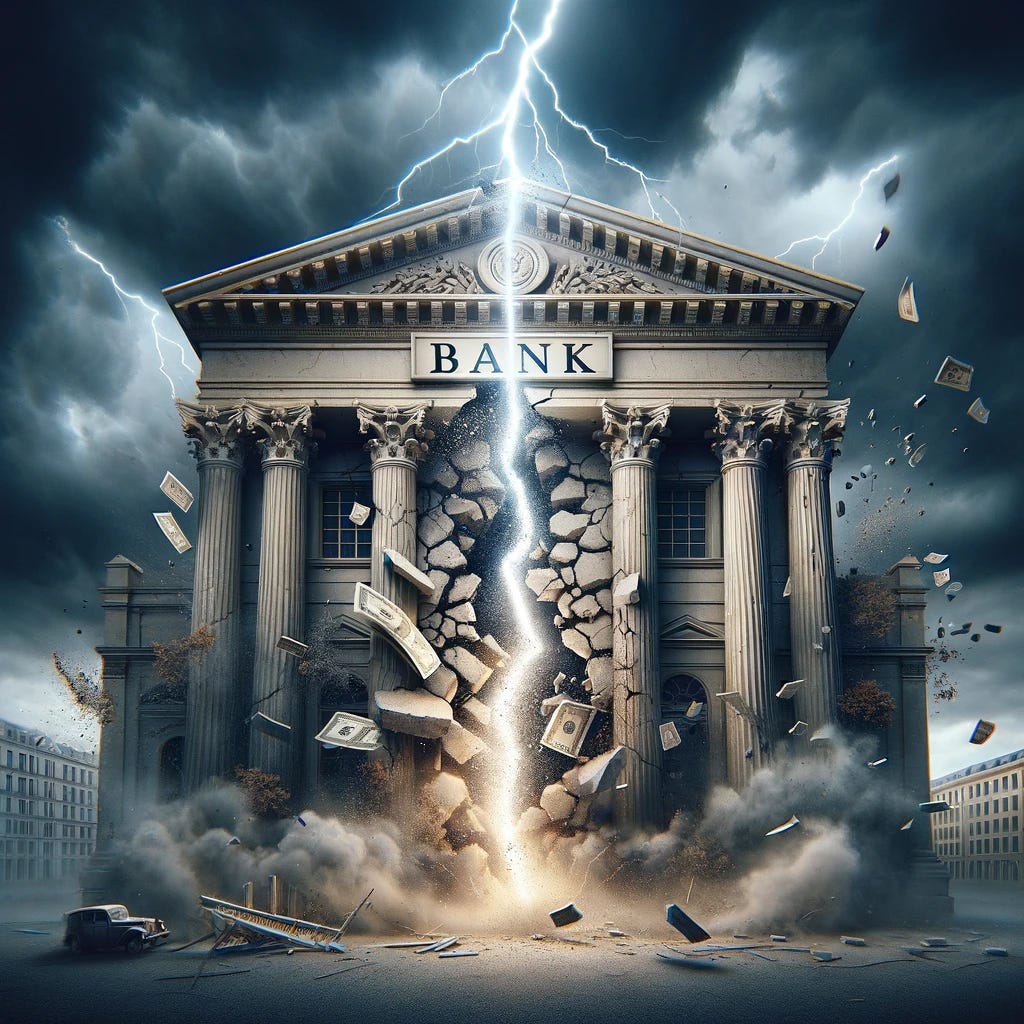On The Razor's Edge
Financial Collapse Isn't By Accident, It's By Design
Gambling isn’t a vice, it’s a requirement.
Banks are some of the most highly leveraged institutions in the world today.
This is a problem when you consider that banks are the connective tissue of the fiat system - any instability has cascading negative effects. That’s why regulators set standards for capital adequacy: According to the latest Fed guidance, large banks must maintain a minimum capital adequacy ratio between 7%-14%.
This is considered adequately capitalized.
In other words, banks are expected to be around 10X leveraged on their risk absorbing equity capital at any given time. This means that even relatively small impairments of their risk-weighted assets are enough to flip equity negative, i.e. render the banks effectively worthless on paper. When this happens, people typically panic and demand their deposits back en masse, which of course can’t be paid.
Now, forget about small impairments. What happens in times of crisis? What happens when longer-dated US Treasuries collapse 46% over just three years? This is precisely what happened between the peak of March 2020 and 2023. Note that this type of drawdown is painful for equities, but it’s absolutely devastating for the bedrock financial layer, i.e. gov bonds. When you combine the fact that the supposedly fail-safe asset had a meltdown that rivaled the Dot-Com bubble, that banks are regulated into holding vast amounts of said Treasuries, and that banks are levered to the hilt, you can pretty much guess what happens.
The result is what we saw last year, with the largest bank failures since 2008.
Didn’t the capitalization requirements help at all?
Hilariously, Treasuries aren’t even factored into the capital requirements because the Government has assigned its own debt with a 0% risk-adjusted weighting, same as cash. After all, how could the instrument of risk-free rates bear any risk?
Safe to say then, that banks are even more leveraged than the capital adequacy ratio would imply. How leveraged exactly? That’s hard to say. In all likelihood, even the banks themselves don’t really understand their off-balance sheet risks.
With so much uncertainty, you would think full-reserve banks would be resurgent. In contrast to today’s fractional-reserve banks, full-reserve banks did not lend out demand deposits and simply charge for valuable services rendered, such as account maintenance, custody, or payment processing services.
But they are not resurgent, quite the opposite. Full-reserve banks are unicorns. For all intents and purposes, they don’t officially exist today. The main reason being, they are de facto banned. Banks that don’t fractionally reserve, that don’t 10X leverage up, and don’t use their clients’ demand deposits as their personal margin accounts, aren’t allowed in the club.
Just ask Caitlin Long from Custodia Bank, who committed to keeping 108% of customer funds on deposit if the Fed would admit her bank to the Federal Reserve System. This membership application was summarily denied for the following reason:
Again, it’s worth highlighting that this supposed “novel business model” is a full-reserve banking model. This goes hand-in-hand with crypto because highly volatile digital bearer assets cannot be fractionally reserved. Crypto companies that do not hold customer deposits in full and in-kind are swiftly margin called and punished by its users. The transgressions of FTX, BlockFi, and Celsius come to mind.
Since the full-reserve banking model is not compatible with the Federal Reserve System, by the Fed’s own admission, and because full-reserve banking is an absolute requirement within crypto, you would expect to see many successful examples of full-reserve banks sprouting up outside of the legacy system.
This is exactly what is happening, except it isn’t obvious.
That’s because modern full-reserve banks aren’t labeled as such. They’re hiding in plain sight. For example, stablecoin Tether just raked in $6.2 billion of net income in 2023, despite having only 125 employees! That makes Tether one of the most profitable companies in the world, more profitable even than Blackrock with its 19’000 employees worldwide. What’s Tether’s magic business model? Simple:
Tether accepts fiat dollar deposits and issues its own digital dollars in return, which can be deployed at light speed in the digital economy. This is the internet age version of the free banking era, where banks would essentially issue their own paper currency, i.e. banknotes. It’s also an extremely lucrative and well-functioning example of full-reserve banking in the 21st century, only we call them stablecoins.
Another example of a full-reserve bank hiding in plain sight is Bitcoin itself - the most lucrative full-reserve banking model of them all. It’s the best performing asset class of all time for one simple reason: Bitcoin can never lie about the coins held on the network, nor about its supply schedule. This is Bitcoin’s key innovation. It is a full-reserve bank in cyberspace that programmatically guarantees its ledger.
Legacy finance will fight this reality. But it will be in vain. The truth is that fractional-reserve banking is built on sand and relies on deceit. It’s constantly on the razor’s edge of waning trust. Financial collapse is baked into the cake. The question is - will the full-reserve system grow quickly enough to absorb the shock?
If you’ve enjoyed this Sunday edition of the Bitcoin Macro Newsletter, please help spread the word by sharing this post with friends and colleagues. We rely on your good word of mouth. Any pledges are greatly appreciated.



As usual, a well detailed analysis of a current nerve shaking banking situation.